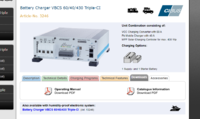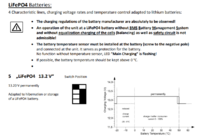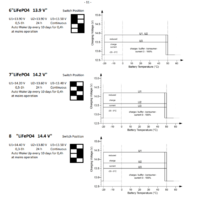I've been doing a bit more digging on my twin LiFePo batteries and it seems that the standard (rather than low temperature) ReLion lithiums can be charged at temperatures down to -20°C BUT between 0° and -10°C the charge current must be reduced to 10% of battery capacity, or 5% if below -10°C. The technical data can be found here:ReLion.
My Votronic VBCS 60/40 triple charger apparently has an operating range of -20° to 45°C, but I doubt that it's clever enough to step down the current dependent upon temperature. However, I may be wrong as their data sheet says this:
I've lifted this from their full specification and data sheet which can be found here if anyone is interested:Votronic
- The temperature compensation (automatic adaptation of the charging voltage to the battery temperature) improves full charging of the weaker battery in case of low outside temperatures and avoids unnecessary battery load and gassing in case of summery temperatures. VOTRONIC chargers are also adapted to the corresponding battery type/characteristic line of charging. For reasons of safety, a gradual reduction of the charging capacity is effected in case of temperatures above 45 °C, and in case of 50 °C (battery overheating), the charging current will be disconnected. Reconnection will be effected automatically after cooling down.
With apologies to @Dellmassive if I've duplicated any of his brilliant advice and guidance. I'm hoping that this means I can still go to Scandinavia!
@ThreeBridgeT6
low temp charge limiting is a feature of this unit provided the temp sensor is installed and the correct program option is set.... see below.
re:
Battery Charger VBCS 60/40/430 Triple-CI

• Connection for Battery Temperature Sensor (included in the standard delivery scope): Lead batteries (acid, gel, AGM): In case of low outside temperatures, full charging of the weak battery is improved by automatic adaptation of the charging voltage to the battery temperature, and in case of summery temperatures unnecessary battery gassing will be avoided. LiFePO4 Batteries: Battery protection in case of high temperatures or particularly in case of low temperatures < 0°C. Highly recommended, if the battery temperature might drop below 0 °C during operation.
temp sensor shown here:

***
Battery Temperature Sensor: Connect the temperature sensor 825 (included in the standard delivery scope) to the terminals "T T" (any polarity). The temperature sensor controls the temperature of the supply battery board "I". Ensure that the installation place of the sensor is not influenced by any source of heat (engine heat, exhaust, heater etc.)!
Lead-Acid, Gel, AGM Batteries: Installation: The thermal contact of sensor and battery inside temperature should be well. Thus, it should be screwed down to the negative pole or positive pole of the battery. It is also possible to fasten it at the sidewall centre of the battery casing.
Function: The temperature-dependent charging voltage of battery I will be adapted automatically to the battery temperature (automatic temperature compensation). The temperature sensor measures the battery temperature. In case of low temperatures (winter operation), the charging voltage will be increased, in order to improve and accelerate full charging of the weak battery. Sensitive consumers are protected by a limitation of the voltage in case of very low outside temperatures. In case of summery temperatures, the charging voltage is reduced to minimize the load (gassing) of the battery and to extend the lifetime of gas-tight batteries.
Battery Protection: In case of excessive battery temperatures (from +50 °C), the charging voltage will be reduced strongly to safety charging voltage, approx. 12.80 V, for battery protection, and the maximum charging current rate will be halved (safety mode, LED "Board I" is flashing). Any charging data being recorded hitherto will be kept in memory. Battery charging is then interrupted, but the supply of consumers being possibly connected will be continued by the unit, and the battery is allowed to cool down. After that, automatic charging will be resumed. Also refer to "Lead Batteries, 4 Characteristic Lines, Charging Voltage Rates and Temperature Compensation", from page 9. The unit recognizes automatically a missing sensor, cable break or short-circuit of the sensor cables, as well as unreasonable measuring values. In that case, it will switch automatically to the usual charging voltage rates of 20 °C / 25 °C being recommended by the battery manufacturers.
LiFePO4 Batteries: Installation: The thermal contact of sensor and inside temperature of the battery should be well. Thus, it should be screwed down to the negative pole of the battery, because in most of the cases, this is the cooler side (the positive pole is often falsified with the exhaust heat of internal fuses, electronic systems for cell equalization, balancers etc.)! Function: In case of abnormal battery temperatures, such as < -20 °C, > 50 °C, the charging voltage will be reduced strongly to safety charging voltage, approx. 12.80 V, for battery protection, and the maximum charging current rate will be halved (safety mode, LED "Board I" is flashing). Any charging data being recorded hitherto will be kept in memory. Battery charging is then interrupted, but the supply of consumers being possibly connected will be continued by the charger until the battery temperature is again in the admissible range. After that, automatic charging will be resumed. In case of temperatures below 0 °C, the charging current will be reduced considerably for battery protection, the LED "Board I" will extinguish every 2 seconds, and longer charging times can be expected. Also refer to 4 Characteristic Lines for "LiFePO4 Batteries, Charging Voltage Rates and Temperature Control", from page 10.
Attention: If the characteristic line had been set for a LiFePO4 battery, the temperature sensor 825 must be connected for reasons of battery safety. Otherwise, the unit does not operate, and the LED "Main Charging" will be flashing!
***

.

.

.

.

.









